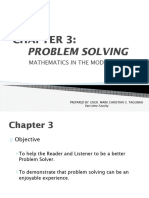0% found this document useful (0 votes)
368 views18 pagesChapter 3 Problem Solving Strategies
The document discusses Polya's four-step problem solving strategy which includes understanding the problem, devising a plan, carrying out the plan, and reviewing the solution. It provides examples of applying each step to solve mathematical word problems involving combinations, patterns in decimals, and counting league games.
Uploaded by
Alfa May BuracCopyright
© © All Rights Reserved
We take content rights seriously. If you suspect this is your content, claim it here.
Available Formats
Download as PDF, TXT or read online on Scribd
0% found this document useful (0 votes)
368 views18 pagesChapter 3 Problem Solving Strategies
The document discusses Polya's four-step problem solving strategy which includes understanding the problem, devising a plan, carrying out the plan, and reviewing the solution. It provides examples of applying each step to solve mathematical word problems involving combinations, patterns in decimals, and counting league games.
Uploaded by
Alfa May BuracCopyright
© © All Rights Reserved
We take content rights seriously. If you suspect this is your content, claim it here.
Available Formats
Download as PDF, TXT or read online on Scribd
/ 18
































































